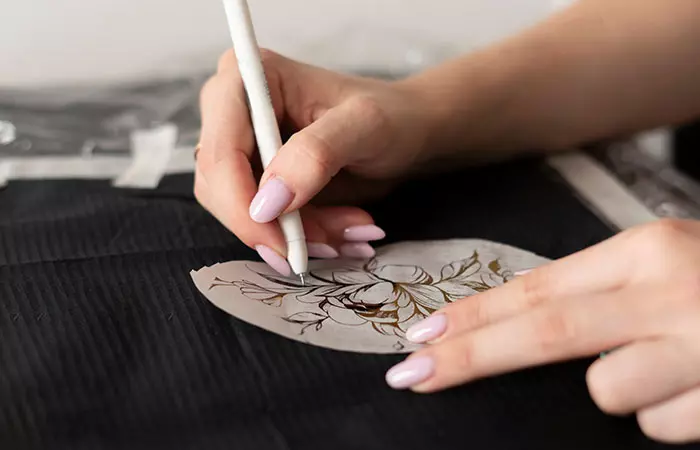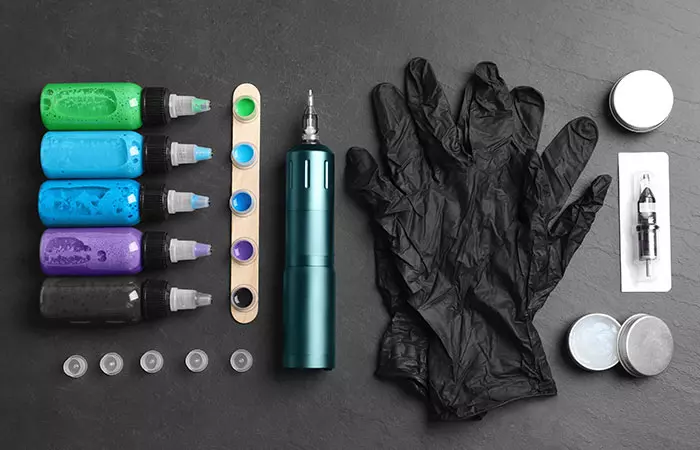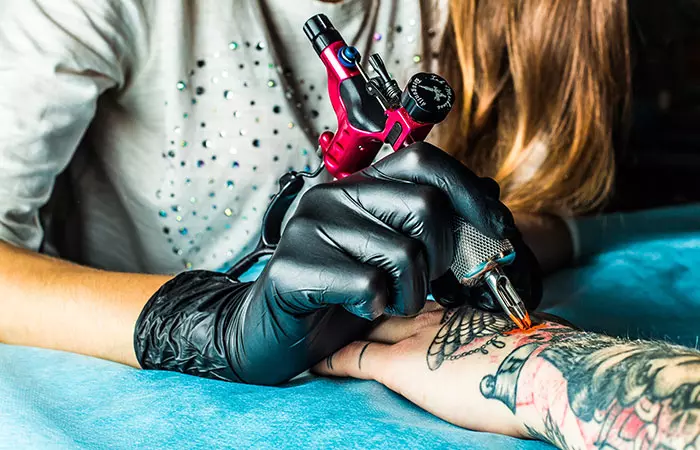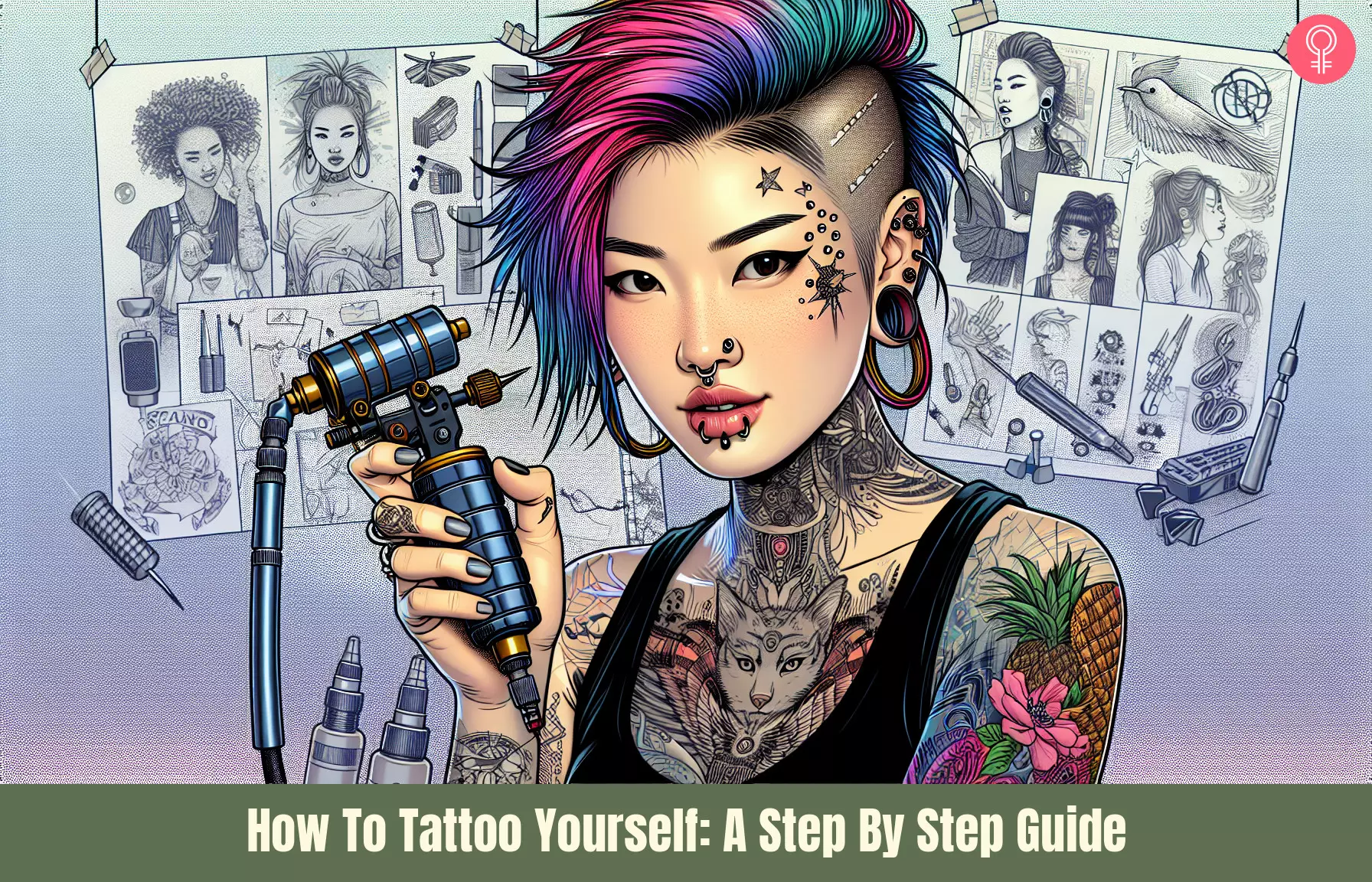
Embarking on the journey of self-expression through body art holds thrilling prospects, and learning how to tattoo yourself can be a profound step towards that quest. It is an intimate dance of ink and skin, a ritual where you become both the creator and the canvas. It is essential to approach this task with care, focus, and a bit of courage. Although tattooing is a complex art, tattooing oneself need not be overwhelming.
By following a simple step-by-step approach, you can easily gain the knowledge required to create something meaningful, on your own terms. This guide is designed to help you understand the basics, from preparing your skin to the final inking, ensuring safety at every step of the way. Remember, each dot of ink is a testament to your story—so get on this creative adventure. At the end of this guide, you will have gained both the technical know-how and a deep appreciation for the craft of tattooing. Jump into this article to learn everything about tattooing yourself!
How Hard Is It To Tattoo Yourself?
 Image: Shutterstock
Image: Shutterstock
Taking on the task of tattooing yourself is no small feat. It is more than just drawing on your skin; it is a meticulous process that requires more than just basic skill. It requires precision, patience, and a steady hand. For starters, you are dealing with a needle that needs to deposit ink into the right layer of skin. Go too shallow, and your tattoo could fade, or not even take properly. Go too deep, and you risk pain, bleeding, and a blurry tattoo or needle trauma instead (1).
Then there is the pain factor. When a professional does it, they can help distract you from the discomfort. But when you’re tattooing yourself, you need to concentrate on the job at hand while also managing your pain response. This can make the process feel more challenging. The needle grip that you need to maintain while bearing through the pain also matters for the sturdy lines you need.
Also, you must remember that you are working in reverse. Imagine writing a letter to yourself in the mirror; that’s what tattooing yourself can feel like. You have to plan and execute the design backward, which can make the whole tattoo process tricky.
And let’s not forget about safety and hygiene. Keeping everything sterile is critical; without proper sanitation, you open yourself up to the risk of infections or infectious diseases.
So, while tattooing yourself is a way to express your individuality, it is essential to weigh whether you are up to the task. If you are determined to learn how to tattoo yourself, or are curious about tattooing yourself, remember—it is a skill that takes practice to perform safely for the desired results.

Aspiring tattoo artists usually practice on fruits such as grapefruit, oranges, and lemons as they closely resemble human skin in texture.
Now that you know what to expect while tattooing yourself, and what you need to be prepared for, check below how to go about the preparation, tools you require, and guidelines you need to consider.
How To Start Tattooing Yourself
 Image: Shutterstock
Image: Shutterstock
It is important to do your homework before you begin the process of tattooing yourself. Research thoroughly about safe practices and consider investing in quality tattooing equipment and inks that are suited to your skin. Also, it is crucial to familiarize yourself with maintaining a sterile work environment to prevent infections.
Once you have researched and gathered your materials, start with a simple design that is within your skill set. Remember, complexity can come later as your confidence and experience grow. Before you make a single mark, practice your design on paper and then on practice skins available in the market. This will give you a feel of the needle and help you perfect your technique.
When it comes to the actual tattooing, choose a part of your body that is easily accessible and has a good amount of flat space, like your thigh. Clean the area thoroughly, shave if necessary, and ensure all your tools are sterilized.
Brianis, a YouTuber and tattoo artist, shared how she went about tattooing her leg. She explains, “So, before we put on the stencil, we want to make sure the skin is clean shaved and ready to put the stencil. So, what I’m going to do is take napkins and [distilled] water and green soap and spray it onto the napkin. You want to kind of soak the napkin but not too much work dripping, just enough and you’re going to take your razor…. Just be careful while shaving (i).” She then proceeded to rub the area with rubbing alcohol to clean the skin of dirt and residue, “so that when the needle penetrates, you don’t get none of that dirtiness going in there.”
Begin by tracing your design with a skin-safe pen or stencil paper. When you are ready, it is time for the ink. Proceed with a light hand, and be patient with yourself. Remember, it is not a race. The key to tattooing yourself successfully is to stay calm and focused. Always keep cleaning supplies on hand to clean the area as you work. Keep warm water and paper towels ready before you start the tattoo process.
Ultimately, the journey to tattooing yourself involves a steep learning curve with a focus on safety and cleanliness. Start slow, be methodical, and don’t shy away from seeking advice from tattoo studio professionals when necessary.
Preparation for tattooing yourself is no small journey, as we have covered above. So, now that you are aware of the process and what to expect, check out the kind of tools you will need to get the process going. Read on to learn more.
What Will You Need To Tattoo Yourself?
 Image: Shutterstock
Image: Shutterstock
Gathering the right tools and materials is the first critical step to begin tattooing yourself.You will need:
Quality Tattoo Machine: This is your primary tool for machine tattoos, and investing in a reliable one ensures smoother lines and a more pleasant tattooing experience. Sterilized Needles: Each clean needle serves a purpose, from enabling finer lines to filling color; hence, variety ensures versatility in your work.Tattoo Ink: Not just any ink will do; you should opt for inks that are vibrant, lasting, and, most importantly, safe for body art.Disposable Ink Cups: Small but vital, they prevent cross-contamination and make switching between colors easy. Latex Gloves: Make sure your latex gloves fit well to avoid slipping, which could affect your precision while you work. You can also opt for vinyl or nitrile gloves Disinfectants: These will be your best friends in keeping skin infections at bay, so never skimp on them and get the best quality ones. Stencil Products: They will help you transfer even the most intricate designs accurately, which will serve as a guide for your needlework. Skin Preparation Supplies: Proper skin prep can reduce the risk of infection and ensure the tattoo area is primed for the ink. These predominantly two products: A fresh, sharp razor, necessary to remove any hair from the tattoo area, and rubbing alcohol, to thoroughly disinfect the area before beginning tattooing. Aftercare Supplies: Quality aftercare promotes healing and can make the difference between a tattoo that heals cleanly and one that does not. It is important to have a proper aftercare ointment to use on a fresh tattoo.
This should serve as a primary list, as, depending on your design, you might need additional supplies. The key is to ensure you have everything on hand before you start to simplify the process and maintain a focus on the process and your safety. When figuring out how to tattoo yourself, being well-prepared with the right supplies is half the battle. Ensure you are equipped, comfortable, and familiar with each item. When you are ready to dive into tattooing yourself, these supplies will help turn your vision into a wearable piece of art.
Tattooing yourself is not an easy task, as we have learned. But, if you feel that you are ready for it, you can move to the next step, which is choosing simple and basic designs to start, and then build from there. Below, we have listed out some simple designs that you can try on yourself.
Easy Tattoo Designs To Do Yourself
 Image: Shutterstock
Image: Shutterstock
When you start out with tattooing yourself, simplicity is your ally. Choosing easy designs can lead to a more satisfying outcome and a smoother learning curve. Here are some simple yet impactful tattoo ideas that suit beginners:
Symbols: Icons like hearts, infinity signs, or anchors are universally recognized and simple to replicate. They often consist of basic lines and shapes, making them manageable for beginners and can easily be built on later, when your skills improve.Initials Or Numbers: Whether it’s a significant date or someone’s initials, these tattoos are personal and straightforward. Stick to a clean, simple font to ensure clarity and ease of tattooing.Geometric Shapes: Think circles, triangles, or squares. They are easy to outline and can be as filled in, or be kept as minimalistic as you like. Geometric tattoos have a timeless appeal and can be quite striking in their simplicity.Nature Elements: Small nature-inspired tattoos, like leaves, stars, or simple flowers, can look elegant and are relatively easy to execute. They can be small, which means less time under the needle and are an ideal choice for a first self-tattoo attempt.Zodiac Signs: Whether you’re into astrology or just like the symbols, zodiac signs are typically simple and small, making them great for beginners. Each sign has a distinct symbol that usually comprises clean lines and curves.Minimalist Animals: Think of a silhouette or the basic outline of an animal or just simple drawings of animals – a tiny elephant, a cat, a whale, or even a bird in flight are adorable choices and simple to ink.Line Art: Single-line art, such as a face profile or an abstract shape, can create impressive tattoos with just one continuous line. This style is forgiving for beginners and still looks chic and modern.Small Quotes Or Words: A single word or a concise phrase in a simple font can be powerful. Choose a word that inspires you or holds personal significance. Ensure the lettering is not too small, which can be challenging to achieve for first-timers.Arrows: Arrows can be designed as simple or as detailed as you like. They have a variety of meanings, from direction to personal achievement, and can look stylish as a tattoo.Mandalas: While intricate mandalas might be complex, simplified versions can be good practice for symmetry. Start with a basic circle and add simple geometric shapes around it, and work your way forward, adding more elements to it.
Remember, when you are taking the first steps to figuring out how to tattoo yourself, the goal is to build confidence and skill. Take your time with these designs, and do not rush the process. You can explore more complex designs as you become more comfortable with the tattoo machine. With each tattoo, you will learn something new about the art of tattoo design and about yourself as an artist.

The most commonly recognised prison tattoo design is the teardrop under the eye, which holds several meanings in the prison system and gang cultures within, such as being an indicator of manslaughter or gang affiliation.
We have discussed the necessary tools, different basic tattoo designs, and what to anticipate while tattooing yourself. Now, it is time to figure out which body parts are the easiest to access to be the perfect canvas for your first self-tattoo.
Easiest Place To Tattoo Yourself
 Image: Shutterstock
Image: Shutterstock
Choosing the right spot to tattoo yourself is about balancing ease of access with comfort. Some such locations are listed below.
The thigh is a prime location for self-tattooing beginners as it is a relatively flat surface, the skin is not overly sensitive, and it is easy to see what you are doing without straining. Plus, the thigh is easily concealed if you want to keep your tattoo under wraps.Another good spot is the outer part of your calf. Like the thigh, it offers a good canvas due to its flatness and visibility. The skin here tends to be less sensitive than other areas, making the tattooing process, especially the pain, a bit more manageable.Your forearm is also a prime location, particularly if you aim to watch closely as you work and learn. Here, the skin’s tightness helps with precision and is also a convenient spot to clean and care for during the healing process.The upper arm, particularly the bicep area, is another relatively easy spot for self-tattooing. It is an accessible area to both see and reach, making it a comfortable choice for many. The skin here can also tolerate the tattooing process well, providing a good healing environment.If you are looking for an area that is a bit hidden, consider the ankle. It is a less fleshy area, which could mean more sensitivity, but it is a small space that is easy to manage for simple designs.The wrist is also a great candidate for a self-tattooing area, mainly because of its easy accessibility. However, it is important to note that the wrist can be more sensitive, and the skin is thinner, so it requires a gentle touch and greater precision.
When figuring out how to tattoo yourself, remember that it is not just the physical ease you are after. You want to feel relaxed and in control, which will help make the experience less stressful and the outcome more successful. If you are left-handed, choose a side that feels more comfortable than the usual options. No matter where you decide to ink, ensure you can maintain a steady hand and a clear view throughout the process. Choose a spot that feels natural to reach and work on, and practice proper aftercare to ensure a good healing process.

The ankle area is the most tattooed body part among women, while for men it is commonly their arms.
Since we have discussed all necessary precautions and prerequisites for the self-tattooing journey, it is only fair to also highlight reasons why this may not be the best idea out the gate. Read below for a few reasons why self-starting the process may not be ideal.
Risks Of Tattooing Yourself You Need To Consider
 Image: Shutterstock
Image: Shutterstock
While the idea of tattooing yourself might hold certain appeal, there are significant reasons to think twice before doing so, some of which are listed below:
Possible Skin Infections: Professional tattoo artists operate under strict hygiene standards to ensure your safety. At home, it is challenging to replicate this sterile environment with clean needles, which increases the health risks and complications for your vulnerable wounded skin.Improper Technique: Professionals are licensed for a reason; they are trained in proper techniques and health regulations that can prevent the spreading of infectious diseases like hepatitis and HIV (2). Without this knowledge, you are putting your health at serious risk.Disappointing Quality Of Artwork: Tattoo professionals have years of experience that allow them to create detailed, precise designs. It is essential to seek the expertise of a professional to avoid the risk of ending up with a poorly executed tattoo that does not meet your expectations. Otherwise, you may need to spend a lot of money on cover-ups or removal of bad tattoos, which can be regretful and costly, not to mention painful.Use Of Low-Quality Equipment: The quality of tattoo equipment available to an experienced tattoo artist in a tattoo parlor versus what you can buy for personal use can often differ significantly. Professional-grade tattoo guns offer precision that is hard to match with over-the-counter kits, affecting the outcome of your tattoo.Pain Management Issues: Tattoo artists are skilled at helping clients cope with the discomfort. But when tattooing yourself, managing pain while concentrating on doing a good job, and maintaining the needle grip can be difficult.Possible Needle Trauma: Getting the depth of the tattoo needle right is crucial. Too shallow, and your tattoo will fade quickly; too deep, and you risk scarring and adverse reactions. Professionals have the expertise to hit the sweet spot, which is hard to gauge when you are alone.Poor Aftercare Practices: A poorly done tattoo with improper aftercare can lead to a difficult healing process, potential allergic reactions, or worse, infections that can leave lasting damage to your skin and overall health.Difficulty With Reach And Perception: Reaching certain areas of your body comfortably, achieving the right angle and pressure, and looking at your skin from an artist’s perspective are all advanced skills that take time to develop. Tattooing is an art that requires a lot of practice. Tattooing yourself alone does not provide you the benefit of an expert eye guiding and correcting your technique, which can stunt your artistic development.
Considering these points, it is clear why one should approach the idea of self-tattooing with caution. It is not just about having the guts to learn how to tattoo yourself but being aware of the potential consequences and recognizing the value of a professional’s skill.
The journey of self-expression through tattoos is beautiful, but it requires the right hands – hands trained to handle the intricacies and challenges of tattoo artistry. So, while the idea of how to tattoo yourself may intrigue you, remember that the results of a DIY approach might not align with the vision in your head.
In this guide, we have explored the intricacies involved in tattooing oneself. From the initial desire to create a tattoo on your own skin to gaining a clear understanding of the complete process, it is evident that tattooing is a form of art that should be entrusted to professionals. Or. at the very least, requires trust in one’s abilities and a clear line of thought. The potential risks involved, ranging from infection to permanent skin damage, are serious concerns that should not be taken lightly.
Your body is a temple, and how you make art on it deserves the utmost care and attention. If you are passionate about getting a tattoo, consider channeling your creativity into drawing skills for designing a piece that a professional artist can bring to life for you. This way, you can ensure your safety and satisfaction with the final masterpiece. On the other hand, if you are really curious about the tattooing process, consider taking classes under professionals to teach yourself a new skill that you can be confident in when practicing on your own.
Frequently Asked Questions
Is it illegal to tattoo yourself?
No, it is not illegal to tattoo yourself in most places. However, there are strict regulations around tattooing others without a license, which vary by location. Despite its legality, tattooing yourself comes with significant risks that should be carefully weighed before plunging in.
How painful is tattooing yourself?
Tattooing yourself can be painful, but the level of pain depends on your personal tolerance threshold and the specific area being tattooed. Some factors that can influence the pain include the size of the tattoo, the location of the tattoo, and your individual pain threshold. It is essential to consider these factors when deciding to tattoo yourself or having someone else tattoo you.
How do you stretch your skin when tattooing yourself?
Stretching the skin is crucial when tattooing yourself. Techniques such as using your body’s position to create tension in the skin, and stretching the skin in any direction once the stencil is applied, can improve the tattooing process. Failing to stretch the skin can lead to gaps, blowouts, and patchy shading.
Key Takeaways
Proper tattooing requires precise tools, a sterile environment, and a deep understanding of skin and ink interaction. Simple designs and accessible body areas are recommended for beginners practicing how to tattoo themselves. Tattooing oneself requires mastering needle depth, a skill that ensures the tattoo’s durability and prevents scarring. Tattooing yourself involves risks like infection and unsatisfactory results that outweigh the allure of a self-made tattoo. Self-tattooing challenges include pain management and the difficulty of inking certain areas of the body accurately and comfortably.
Image: Dall·E/StyleCraze Design Team
Tattooing yourself is no easy feat, and it requires research, precision, and practice. Here’s an informative video of a tattoo artist tattooing herself. Check it out to learn pointers on how to do it for yourself.
Personal Experience: Source
StyleCraze’s articles are interwoven with authentic personal narratives that provide depth and resonance to our content. Below are the sources of the personal accounts referenced in this article.
(i) Tattoo Shading tutorial (Tatting Myself)https://www.youtube.com/watch?v=oj_YT7EjPT8 Was this article helpful?
Leave a Reply